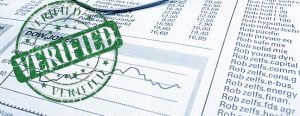Meaning Of Verification
It is the duty of the auditor that he specifically writes in his report whether the financial position of the organization represented in the Balance Sheet is proper or not. He must make sure that all the assets shown in the Balance Sheet are present with the organization or not, the organization has valued them properly or not, they are free from all kinds of mortgages, etc. or not. Similarly, he has ‘to make sure about all liabilities also. In this way, the auditor evaluates the assets and liabilities of the organization and verifies them, and this work of the auditor is called Verification.
Read about Verification Parameters
Verification of assets is a process by which the auditor certifies that the assets shown in the Balance Sheet are correct. Explaining the complete objective of verification J.R. Batliboi Boy has said that
Auditor should satisfy himself that the assets are present on the date of Balance Sheet, and they are free of any charge or mortgage and their valuation is done in proper manner.
 The auditor must take all kinds of care in relation to assets. He should check all documents of title, receipts, etc. related to the assets. Mostly these documents of title are with the trader but if they are with some other person like banks etc., then they should be attained from them. He should not show any kind of relaxation in this. In relation to verification of assets, the position of an auditor is specified in a court case that for verification of assets, the auditor should take care of the following points
The auditor must take all kinds of care in relation to assets. He should check all documents of title, receipts, etc. related to the assets. Mostly these documents of title are with the trader but if they are with some other person like banks etc., then they should be attained from them. He should not show any kind of relaxation in this. In relation to verification of assets, the position of an auditor is specified in a court case that for verification of assets, the auditor should take care of the following points
- All the assets are included in the Balance Sheet of the organization and are shown clearly.
- Assets are valued properly
- On the date of preparation of the Balance Sheet, the assets were physically present with the organization.
- All the assets were in possession of the organization and were free from any charge or mortgage.
- Assets were owned by the organization and not by anyone else.
Objectives Of Verification
The main objective of verification is to check the following
points
- Whether all assets and liabilities are mathematically accurate or not.
- All assets are properly accounted for, as per the rules of the organization and legal provisions, or not
- All the assets shown in the Balance Sheet are present or not, and at the time of preparation of the Balance Sheet, they were present with the organization, or not.
- Any such change.is made in an asset that is not shown in the Balance Sheet. In other words, assets are shown keeping in view all the related provisions, or not.
- Whether fictitious Assets are written off adequately, or not.
- Valuation of assets and liabilities is done according to the accounting principles or not and valuation is correct according to the previous year, or not.
- No fraud or irregularities occurred in relation to the assets and liabilities of the organization.
- All the assets and liabilities of the organization are shown or not and none is hidden.
- Assets shown in the Balance Sheet are present or not and they are owned by the organization or not. It might be that some assets are not in the possession of the organization, like – on taking a loan from a bank, the assets or stock of the organization is kept in the goodwill of the bank. But in such a case, the organization has legal rights over such assets, and it is considered the property of the organization.
